Spatial–Temporal Variability of Climatic Water Balance in the Brazilian Savannah Region River Basins
Abstract
:1. Introduction
2. Materials and Methods
2.1. Study Area
2.2. Monthly Climatic Water Balance (CWB)
- F = frequency (%)
- m = order of the monthly water deficit and/or surplus event; and
- n = number of observations.
2.3. Analysis of the Stationarity of the Historical Series of the Monthly Climatic Water Balance (CWB), Precipitation (P), and Reference Evapotranspiration (ETo)
3. Results and Discussion
3.1. Reference Evapotranspiration (ETo) and Precipitation (P) in the Cerrado
3.2. Evaluation of Monthly Water Deficit and Surplus
3.3. Evaluation of the Stationarity of the Data of Monthly Climatic Water Balance (CWB) and the Input Variables Precipitation (P) and Reference Evapotranspiration (ETo)
3.4. Relationship between the Variation of the Climatic Water Balance (CWB) and Water Availability
4. Conclusions
Author Contributions
Funding
Data Availability Statement
Conflicts of Interest
References
- Assad, E.D.; Victoria, D.D.e.C.; Cuadra, S.V.; Pugliero, V.S.; Zanetti, M.R. Efeito das mudanças climáticas na agricultura do Cerrado. In Dinâmica Agrícola no Cerrado: Análises e Projeções, 1st ed.; Bolfe, E.L., Sano, E.E., Campos, S.K., Eds.; Embrapa Sede: Brasília, Brazil, 2020. [Google Scholar]
- Bolfe, E.L.; Sano, E.E.; Campos, S.K. Introdução. In Dinâmica Agrícola no Cerrado: Análises e Projeções, 1st ed.; Bolfe, E.L., Sano, E.E., Campos, S.K., Eds.; Embrapa Sede: Brasília, Brazil, 2020; pp. 15–20. [Google Scholar]
- CONAB—Companhia Nacional de Abastecimento. Safras Grãos: Série Histórica. 2018. Available online: https://www.conab.gov.br/info-agro/safras/serie-historica-das-safras (accessed on 20 May 2020).
- IBGE—Instituto Brasileiro de Geografia e Estatística. Produção Agrícola e Pecuária Municipal: Censo Agropecuário, Produção e Extração Vegetal da Silvicultura; IBGE: Rio de Janeiro, Brazil, 2018. Available online: https://sidra.ibge.gov.br/home/pms/brasil (accessed on 20 May 2020).
- Oliveira, P.T.S.; Nearing, M.A.; Moran, M.S.; Goodrich, D.C.; Wendland, E.; Gupta, H.V. Trends in water balance components across the Brazilian Cerrado. Water Resour. Res. 2014, 50, 7100–7114. [Google Scholar] [CrossRef]
- Francisco, E.A.B.; Kappes, C. Cerrado brasileiro carece de mais investimentos em práticas sustentáveis. Visão Agrícola 2012, 10, 55–57. [Google Scholar]
- Rodrigues, L.N. Quantidade de água utilizada na agricultura irrigada: Certezas e incertezas nas estimativas. ITEM Irrig. Tecnol. Mod. 2017, 114, 47–53. [Google Scholar]
- ANA—Agência Nacional de Águas. Atlas Irrigação: Uso da Agua na Agricultura Irrigada; ANA: Brasília, Brasil, 2017; p. 86. Available online: http://biblioteca.ana.gov.br/asp/download.asp?codigo=129435&tipo_midia=2&iIndexSrv=1&iUsuario=0&obra=72512 (accessed on 2 May 2022).
- Ministério da Integração e do Desenvolvimento Regional. Análise Territorial Para o Desenvolvimento da Agricultura Irrigada no Brasil; Ministério da Integração e do Desenvolvimento Regional: Brasília, Brazil, 2014; p. 217. Available online: https://www.gov.br/mdr/pt-br (accessed on 15 June 2022).
- Althoff, D.; Rodrigues, L.N. The expansion of center-pivot irrigation in the Cerrado biome. Irriga 2019, 1, 56–61. [Google Scholar] [CrossRef]
- Cambraia Neto, A.J.; Rodrigues, L.N. Impact of land use and occupation on potential groundwater recharge in a Brazilian savannah watershed. Water Int. 2021, 46, 348–364. [Google Scholar] [CrossRef]
- Burek, P.; Satoh, Y.; Fischer, G.; Kahil, M.T.; Scherzer, A.; Tramberend, S.; Nava, L.F.; Wada, Y.; Eisner, S.; Flörke, M.; et al. Water Futures and Solution: Fast Track Initiative (Final Report); IIASA Working Paper; WP-16–006; IIASA: Laxenburg, Austria, 2016; Available online: https://pure.iiasa.ac.at/13008 (accessed on 15 June 2022).
- Salis, H.H.C.; Evangelista, L.P.; Costa, A.M.; Horta, I.D.M.F. Diagnóstico da disponibilidade hídrica na bacia hidrográfica do rio Manso-MG. Caminhos Geogr. 2017, 18, 91–102. [Google Scholar] [CrossRef]
- Santos, E.F.N.; Barreto, I.D.C.; Barbosa, E.A.S.; Campos, L.; Silva, A.S.A. Contribuição de técnicas multivariadas a índices de seca na compreensão das otto-regiões da bacia do São Francisco. Res. Soc. Dev. 2021, 10, e7210313118. [Google Scholar] [CrossRef]
- Rápalo, L.M.C.; Uliana, E.M.; Moreira, M.C.; Silva, D.D.; Ribeiro, C.B.M.; Cruz, I.F.; Pereira, D.R. Effects of land-use and-cover changes on streamflow regime in the Brazilian Savannah. J. Hydrol. Reg. Stud. 2021, 38, 100934. [Google Scholar] [CrossRef]
- Behzadi, F.; Yousefi, H.; Javadi, S.; Moridi, A.; Shahedany, S.M.H.; Neshat, A. Meteorological drought duration–severity and climate change impact in Iran. Theor. Appl. Climatol. 2022, 149, 1297–1315. [Google Scholar] [CrossRef]
- Moreira, A.A.; Ruhoff, A.L.; Roberti, D.R.; Souza, V.A.; Rocha, H.R.; Paiva, R.C.D. Assessment of terrestrial water balance using remote sensing data in South America. J. Hydrol. 2019, 575, 131–147. [Google Scholar] [CrossRef]
- ANA—Agência Nacional de Águas. Conjuntura dos Recursos Hídricos no Brasil 2017: Relatório Pleno; ANA: Brasília, Brasil, 2017; p. 169. Available online: https://www.snirh.gov.br/portal/centrais-de-conteudos/conjuntura-dos-recursos-hidricos/relatorio-conjuntura-2017.pdf/@@download/file/relatorio-conjuntura-2017.pdf (accessed on 15 May 2022).
- Souza, J.L.M.; Jerszurki, D.; Schafer, R.; Gurski, B.C.; Schafer, H. Balanço hídrico climatológico: Precipitação e evapotranspiração de referência estimadas com metodologia alternativa. Rev. Bras. Climatol. 2017, 20. [Google Scholar] [CrossRef]
- Berghuijs, W.R.; Sivapalan, M.; Woods, R.A.; Savenije, H.H. Patterns of similarity of seasonal water balances: A window into streamflow variability over a range of time scales. Water Resour. Res. 2014, 50, 5638–5661. [Google Scholar] [CrossRef]
- Jesus, T.C.L.; Senna, M.C.A.; Cataldi, M.; Paiva, C.M.; Franz, B. Impacto do aumento da concentração atmosférica de CO2 no balanço hídrico climatológico do Cerrado. Rev. Bras. Climatol. 2017, 21. Available online: https://ojs.ufgd.edu.br/index.php/rbclima (accessed on 20 May 2022). [CrossRef]
- Byrne, M.P.; O’Gorman, P.A. The response of precipitation minus evapotranspiration to climate warming: Why the “wet-get-wetter, dry-get-drier” scaling does not hold over land. J. Clim. 2015, 28, 8078–8092. [Google Scholar] [CrossRef]
- Ferreira, F.L.V.; Rodrigues, L.N.; Silva, D.D. Influence of changes in land use and land cover and rainfall on the streamflow regime of a watershed located in the transitioning region of the Brazilian Biomes Atlantic Forest and Cerrado. Environ. Monit. Assess. 2021, 193, 1–17. [Google Scholar] [CrossRef]
- Passos, M.L.V.; Zambrzycki, G.C.; Pereira, R.S. Balanço hídrico climatológico e classificação climática para o município de Balsas-MA. Sci. Agrar. 2017, 18, 83–89. [Google Scholar] [CrossRef]
- Cassettari, G.A.; Queiroz, T.M. Balanço hídrico e classificação climática na bacia do rio Jauquara, região de transição entre o cerrado e Amazônia brasileira. Rev. Bras. Climatol. 2020, 26. [Google Scholar] [CrossRef]
- Soares, A.K.; Ohnuma, A.A., Jr.; Borges, A.C.; Pagnossi, A.A.; Angelotti Netto, A.; Corrêa Filho, C.R.R.; Mendiondo, E.M. Análise do balanço hídrico serial na bacia da represa do Broa, SP. Simpósio Bras. Recur. Hídricos 2003, 15. Available online: https://files.abrhidro.org.br/Eventos/Trabalhos/154/285.pdf (accessed on 13 January 2022).
- D’Angiolella, G.L.B.; Vasconcellos, V.L.D.; Rodriguez, F.A. Balanço hídrico climático do Mato Grosso e Mato Grosso do Sul. In Proceedings of the XV Congresso Brasileiro de Agrometeorologia, Aracaju, Brazil, 2–5 July 2007; Available online: http://www.sbagro.org/files/biblioteca/2641.pdf (accessed on 14 January 2022).
- Carvalho, H.D.P.; Dourado Neto, D.; Teodoro, R.E.F.; Melo, B.D. Balanço hídrico climatológico, armazenamento efetivo da água no solo e transpiração na cultura de café. Biosci. J. 2011, 27, 221–229. Available online: http://fi-admin.bvsalud.org/document/view/zwcsy (accessed on 15 January 2022).
- Santos, G.O.; Martins, G.R.; Blat, N.R.; Mendonça, L.B. Disponibilidade hídrica e as anomalias climáticas no cultivo de soja e milho no Cerrado. J. Biotechnol. Biodivers. 2022, 10, 214–222. [Google Scholar] [CrossRef]
- De Oliveira, J.A.M. Estimativa do balanço hídrico climatológico e classificação climática para o município de Carbonita—MG. Rev. Bras. Geogr. Física 2023, 16, 755–764. [Google Scholar] [CrossRef]
- Mapbiomas. Coleção 4.1. 2020. Available online: https://mapbiomas-br-site.s3.amazonaws.com/Mapa%20Mural/Mapbiomas_2018_Col4_1_Cerrado.pdf (accessed on 4 June 2020).
- ANA—Agência Nacional de Águas. Codificação de Bacias Hidrográficas Pelo Método Otto Pfafstetter. 2014. Available online: https://capacitacao.ead.unesp.br/dspace/bitstream/ana/104/1/apostila.pdf (accessed on 4 May 2020).
- Alvares, C.A.; Stape, J.L.; Sentelhas, P.C.; Gonçalves, J.L.M.; Sparovek, G. Köppen’s climate classification map for Brazil. Meteorol. Z. 2013, 22, 711–728. [Google Scholar] [CrossRef] [PubMed]
- Klink, C.A. Policy intervention in the cerrado savannas of Brazil: Changes in land use and effects on conservation. In Ecology and Conservation of the Maned Wolf: Multidisciplinary Perspectives; Consorte-McCrea, E., Santos, F., Eds.; CRC Press: Boca Raton, FL, USA, 2014; pp. 293–308. [Google Scholar]
- Rodrigues, L.N.; Sano, E.E.; Steenhuis, T.S.; Passo, D.P. Estimation of small reservoir storage capacities with remote sensing in the Brazilian Savannah Region. Water Resour. Manag. 2012, 26, 873–882. [Google Scholar] [CrossRef]
- Althoff, D.; Rodrigues, N.L.; Silva, D.D. Assessment of water availability vulnerability in the Cerrado. Appl. Water Sci. 2021, 11, 1–14. [Google Scholar] [CrossRef]
- Prăvălie, R.; Piticar, A.; Roșca, B.; Sfîcă, L.; Bandoc, G.; Tiscovschi, A.; Patriche, C. Spatio-temporal changes of the climatic water balance in Romania as a response to precipitation and reference evapotranspiration trends during 1961–2013. Catena 2019, 172, 295–312. [Google Scholar] [CrossRef]
- R Development Core Team, R. A Language and Environment for Statistical Computing; R Foundation for Statistical Computing: Vienna, Austria, 2021; Available online: http://www.r-project.org (accessed on 30 November 2021).
- Althoff, D.; Rodrigues, L.N.; Silva, D.D. Predicting runoff series in ungauged basins of the Brazilian Cerrado biome. Environ. Model. Softw. 2022, 149, 105315. [Google Scholar] [CrossRef]
- Huffman, G.J.; Bolvin, D.T.; Braithwaite, D.; Hsu, K.; Joyce, R.; Kidd, C.; Nelkin, E.J.; Sorooshian, S.; Tan, J.; Xie, P. Integrated Multi-Satellite Retrievals for GPM (IMERG): Algorithm Theoretical Basis Document; National Aeronautics and Space Administration: Washington, DC, USA, 2019; p. 8. Available online: https://docserver.gesdisc.eosdis.nasa.gov/public/project/GPM/IMERG_ATBD_V06.pdf (accessed on 2 July 2022).
- Huffman, G.J.; Stocker, E.F.; Bolvin, D.T.; Nelkin, E.J.; Tan, J. GPM IMERG Final Precipitation L3 1 Day 0.1 Degree x 0.1 Degree V06; Goddard Earth Sciences Data and Information Services Center (GES DISC): Greenbelt, MD, USA, 2019; Available online: https://doi.org/10.5067/GPM/IMERGDF/DAY/06 (accessed on 6 July 2022).
- Althoff, D.; Dias, S.H.B.; Filgueiras, R.; Rodrigues, L.N. ETo-Brazil: A Daily Gridded Reference Evapotranspiration Data Set for Brazil (2000–2018). Water Resour. Res. 2020, 56, e2020WR027562. [Google Scholar] [CrossRef]
- Kimball, B.F. On the choice of plotting positions on probability paper. J. Am. Stat. Assoc. 1960, 55, 546–560. [Google Scholar] [CrossRef]
- Thom, H.C.S. Some methods of climatological analysis. World Meteorol. Organ. 1966, 81, 53. [Google Scholar]
- Mann, H.B. Nonparametric tests against trend. Econom. J. Econom. Soc. 1945, 13, 245–259. [Google Scholar] [CrossRef]
- Kendall, M.G. Rank Correlation Methods; Charles Griffin: London, UK, 1975. [Google Scholar]
- Pettitt, A.N. A non-parametric approach to the change-point problem. J. R. Stat. Soc. Ser. C 1979, 28, 126–135. [Google Scholar] [CrossRef]
- Sen, P.K. Estimates of the regression coefficient based on Kendall’s tau. J. Am. Stat. Assoc. 1968, 63, 1379–1389. [Google Scholar] [CrossRef]
- Hirsch, R.M.; Slack, J.R.; Smith, R.A. Techniques of trend analysis for monthly water quality data. Water Resour. Res. 1982, 18, 107–121. [Google Scholar] [CrossRef]
- Mudbhatkal, A.; Raikar, R.V.; Venkatesh, B.; Mahesha, A. Impacts of climate change on varied river-flow regimes of southern India. J. Hydrol. Eng. 2017, 22. [Google Scholar] [CrossRef]
- Ferreira, F.L.V.; Rodrigues, L.N.; Silva, D.D.D.; Teixeira, D.B.D.S.; Almeida, L.T.D. Time Series Trends of Streamflow and Rainfall in the Santo Antônio River Basin, Brazil. Eng. Agrícola 2021, 41, 47–55. [Google Scholar] [CrossRef]
- Sano, E.E.; Rodrigues, A.A.; Martins, E.S.; Bettiol, G.M.; Bustamante, M.M.; Bezerra, A.S.; Couto, A.F., Jr.; Vascocelos, V.; Schüler, J.; Bolfe, E.L. Cerrado ecoregions: A spatial framework to assess and prioritize Brazilian savanna environmental diversity for conservation. J. Environ. Manag. 2019, 232, 818–828. [Google Scholar] [CrossRef]
- Campos, J.D.O.; Chaves, H.M.L. Trends and variabilities in the historical series of monthly and annual precipitation in cerrado biome in the period 1977–2010. Rev. Bras. Meteorol. 2020, 35, 157–169. [Google Scholar] [CrossRef]
- Di Nunno, F.; Granata, F. Future trends of reference evapotranspiration in Sicily based on CORDEX data and Machine Learning algorithms. Agric. Water Manag. 2023, 280, 108232. [Google Scholar] [CrossRef]
- Salviano, M.F.; Groppo, J.D.; Pellegrino, G.Q. Análise de tendências em dados de precipitação e temperatura no Brasil. Rev. Bras. Meteorol. 2016, 31, 64–73. [Google Scholar] [CrossRef]
- Beebe, D.A.; Castle, J.W.; Molz, F.J.; Rodgers, J.H., Jr. Effects of evapotranspiration on treatment performance in constructed wetlands: Experimental studies and modeling. Ecol. Eng. 2014, 71, 394–400. [Google Scholar] [CrossRef]
- Sousa, F.A.; Moura, D.M.B. Evapotranspiração potencial (ETp) e sua influência na vazão de rios do Cerrado Brasileiro. Elisée Rev. Geo. 2022, 11, e111222. [Google Scholar] [CrossRef]
- Siqueira, P.P.; Oliveira, P.T.S.; Bressiani, D.; Neto, A.A.M.; Rodrigues, D.B. Effects of climate and land cover changes on water availability in a Brazilian Cerrado basin. J. Hydrol. Reg. Stud. 2021, 37, 100931. [Google Scholar] [CrossRef]
- Egger, D.S.; Rigotto, R.M.; Souza, F.A.N.; Costa, A.M.; Aguiar, A.C.P. Ecocídio nos Cerrados: Agronegócio, espoliação das águas e contaminação por agrotóxicos. Desenvolv. Meio Ambiente 2021, 57, 16–54. [Google Scholar] [CrossRef]
- Hofmann, G.S.; Cardoso, M.F.; Alves, R.J.; Weber, E.J.; Barbosa, A.A.; Toledo, P.M.; Pontual, F.B.; Salles, L.D.O.; Hasenack, H.; Cordeiro, J.L.P.; et al. The Brazilian Cerrado is becoming hotter and drier. Glob. Change Biol. 2021, 27, 4060–4073. [Google Scholar] [CrossRef]
- Althoff, D.; Bazame, H.C.; Filgueiras, R.; Rodrigues, L.N. Assessing rainfall spatial variability in the Brazilian savanna region with TMPA rainfall dataset. J. South Am. Earth Sci. 2021, 111, 103482. [Google Scholar] [CrossRef]
- Pousa, R.; Costa, M.H.; Pimenta, F.M.; Fontes, V.C.; Brito, V.F.A.D.; Castro, M. Climate change and intense irrigation growth in Western Bahia, Brazil: The urgent need for hydroclimatic monitoring. Water 2019, 11, 933. [Google Scholar] [CrossRef]
- Hoffmann, W.A.; Jackson, R.B. Vegetation–climate feedbacks in the conversion of tropical savanna to grassland. J. Clim. 2000, 13, 1593–1602. [Google Scholar] [CrossRef]
- Costa, M.H.; Pires, G.F. Effects of Amazon and Central Brazil deforestation scenarios on the duration of the dry season in the arc of deforestation. Int. J. Climatol. 2010, 30, 1970–1979. [Google Scholar] [CrossRef]
- Lee, J.E.; Lintner, B.R.; Boyce, C.K.; Lawrence, P.J. Land use change exacerbates tropical South American drought by sea surface temperature variability. Geophys. Res. Lett. 2011, 38. [Google Scholar] [CrossRef]
- Salazar, A.; Baldi, G.; Hirota, M.; Syktus, J.; McAlpine, C. Land use and land cover change impacts on the regional climate of non-Amazonian South America: A review. Glob. Planet. Change 2015, 128, 103–119. [Google Scholar] [CrossRef]
- Arantes, A.E.; Ferreira, L.G.; Coe, M.T. The seasonal carbon and water balances of the Cerrado environment of Brazil: Past, present, and future influences of land cover and land use. ISPRS. J. Photogramm. Remote Sens. 2016, 117, 66–78. [Google Scholar] [CrossRef]
- Spera, S.A.; Galford, G.L.; Coe, M.T.; Macedo, M.N.; Mustard, J.F. Land-use change affects water recycling in Brazil’s last agricultural frontier. Glob. Change Biol. 2016, 22, 3405–3413. [Google Scholar] [CrossRef] [PubMed]
- Debortoli, N.S.; Dubreuil, V.; Hirota, M.; Filho, S.R.; Lindoso, D.P.; Nabucet, J. Detecting deforestation impacts in Southern Amazonia rainfall using rain gauges. Int. J. Climatol. 2016, 37, 2889–2900. [Google Scholar] [CrossRef]
- Milhorance, C.; Sabourin, E.; Chechi, A.L. Adaptação às Mudanças Climáticas e Integração de Políticas Públicas no Semiárido Pernambucano; Working Paper; Brasília, Brazil. 2018, Volume 1, p. 44. Available online: http://inct-odisseia.i3gs.org/wp-content/uploads/2019/12/WP2.pdf (accessed on 19 February 2022).
- Alizadeh, H.; Mousavi, S.J. Coupled stochastic soil moisture simulation-optimization model of deficit irrigation. Water Resour. Res. 2013, 49, 4100–4113. [Google Scholar] [CrossRef]
- Evans, R.G.; Sadler, E.J. Methods and technologies to improve efficiency of water use. Water Resour. Res. 2008, 44. [Google Scholar] [CrossRef]
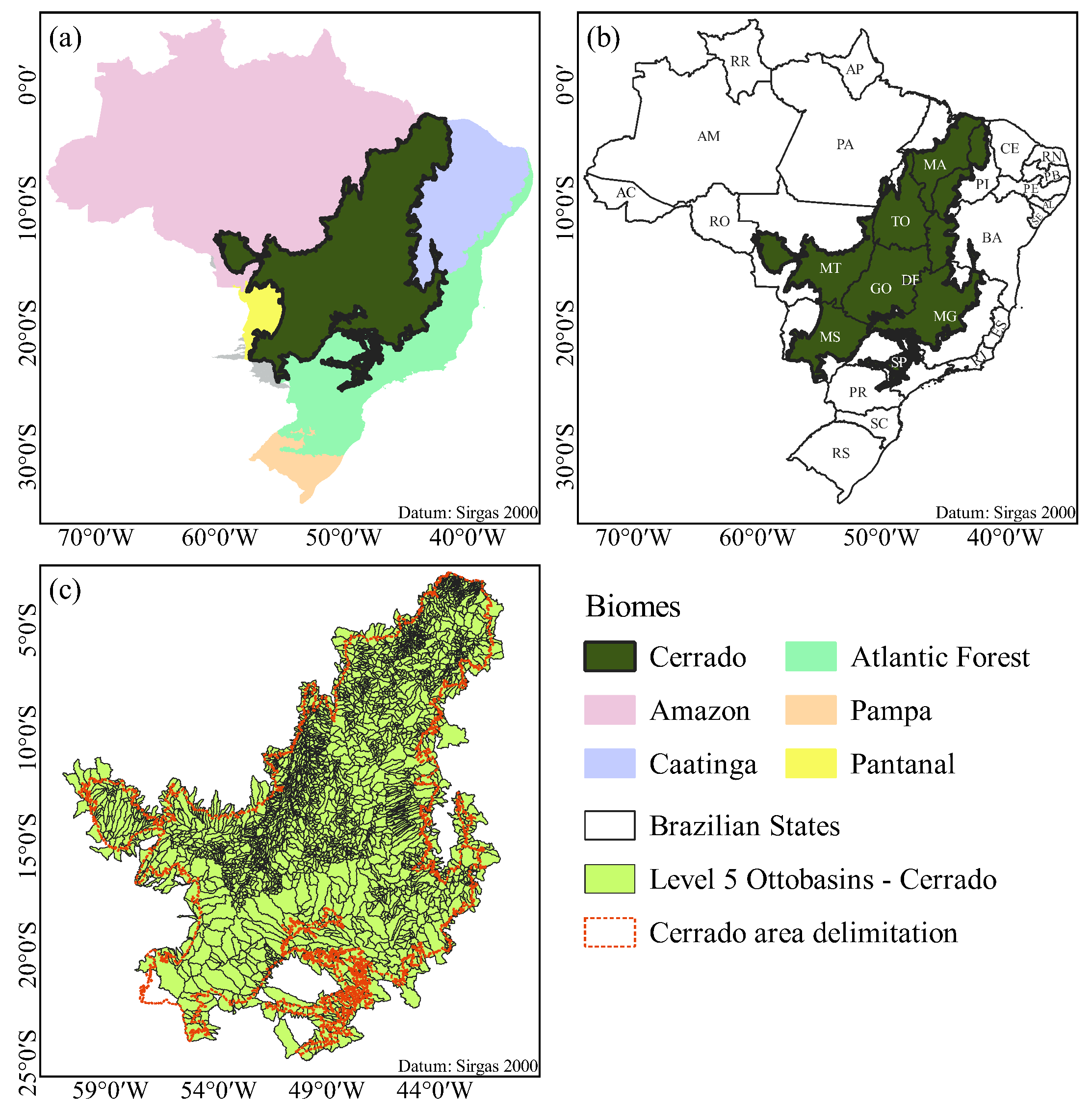


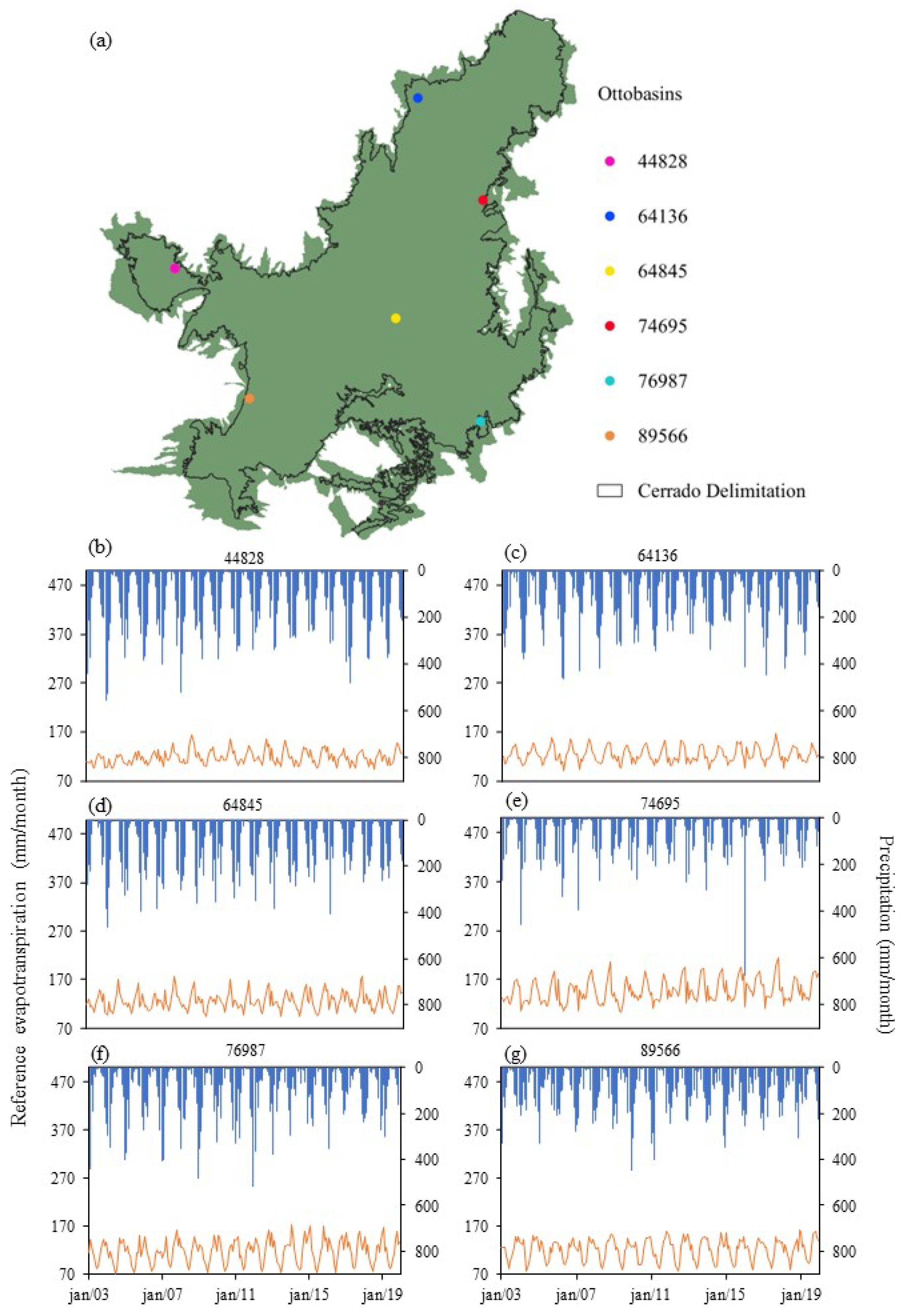
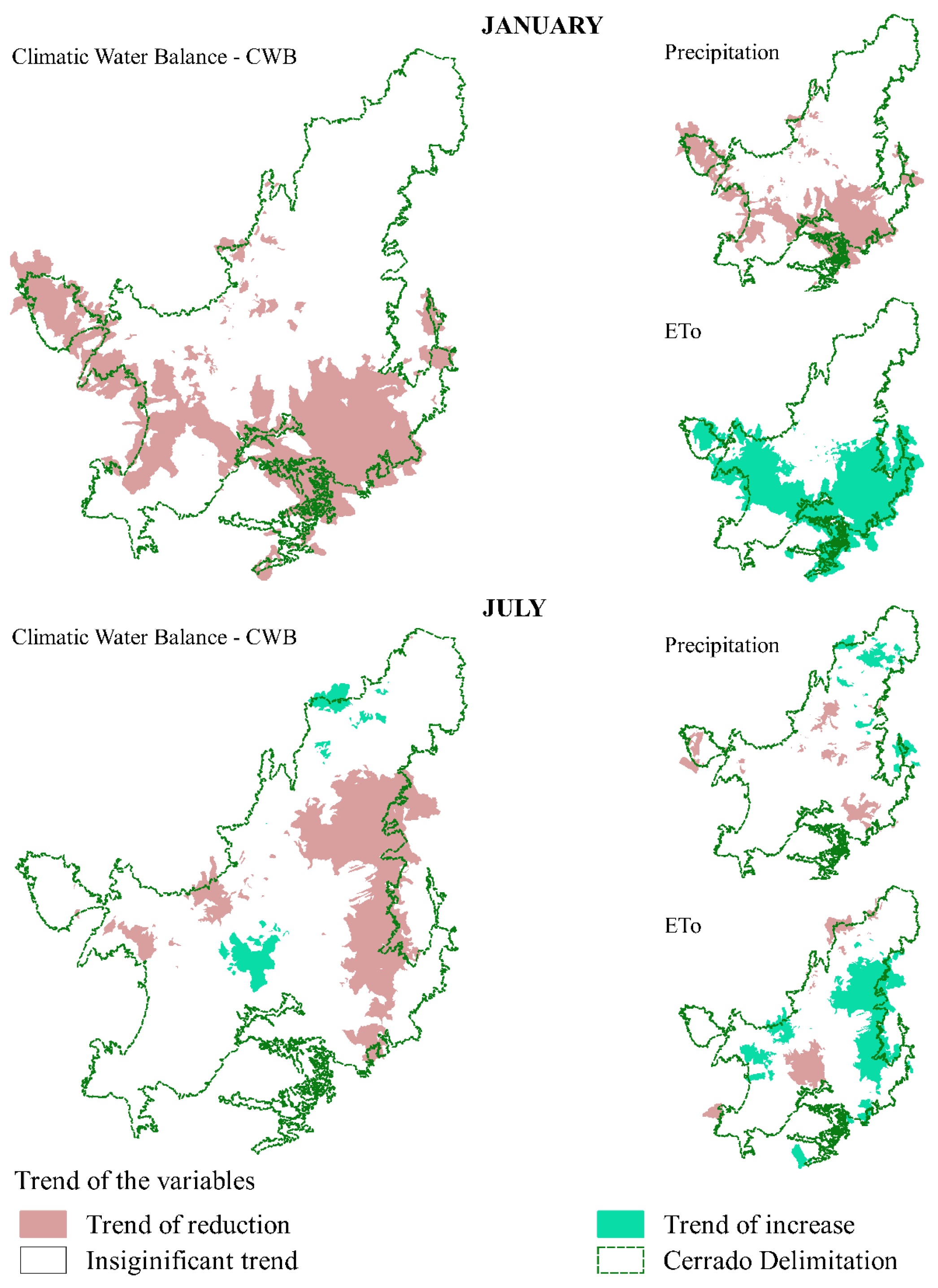
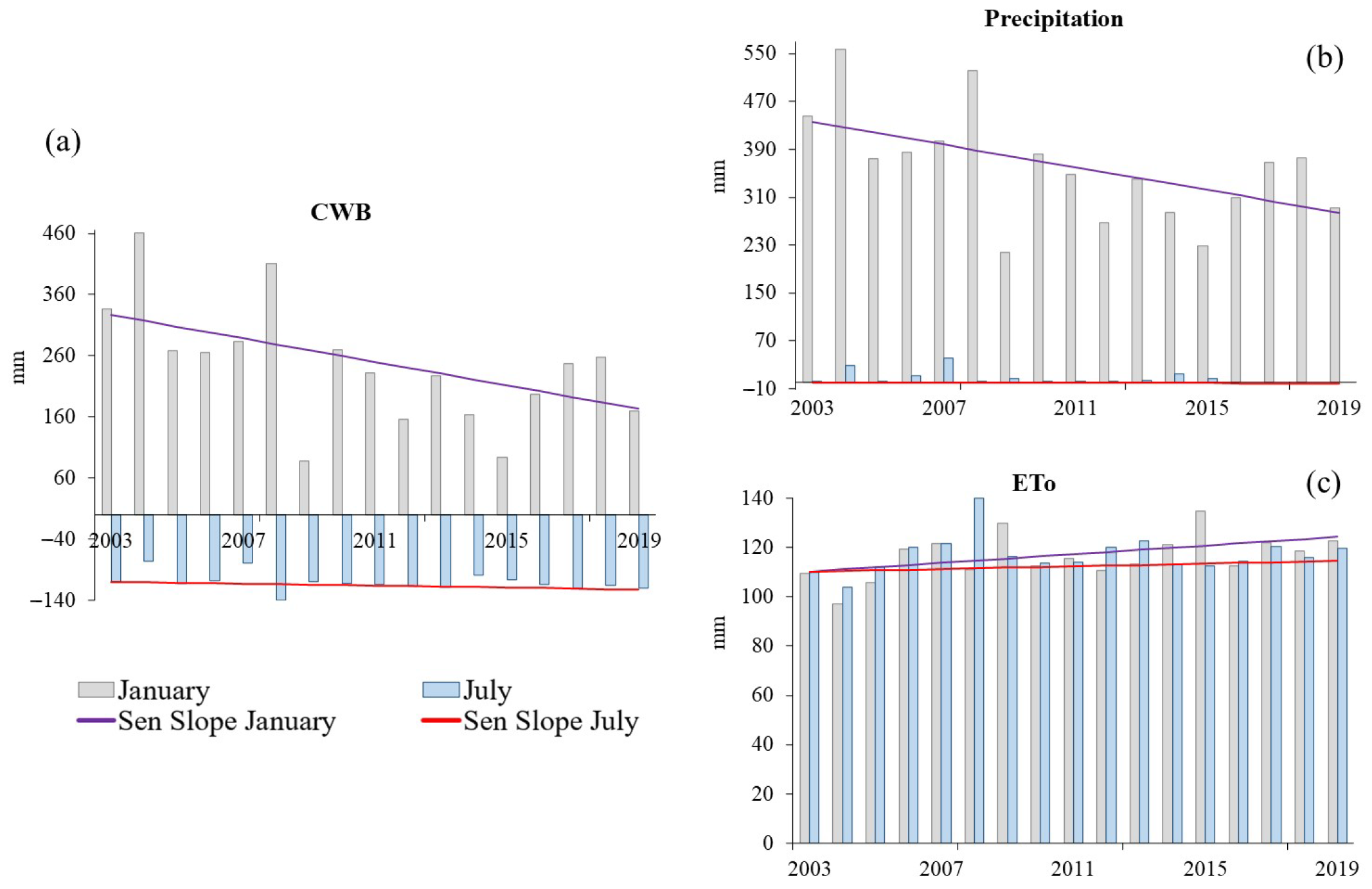
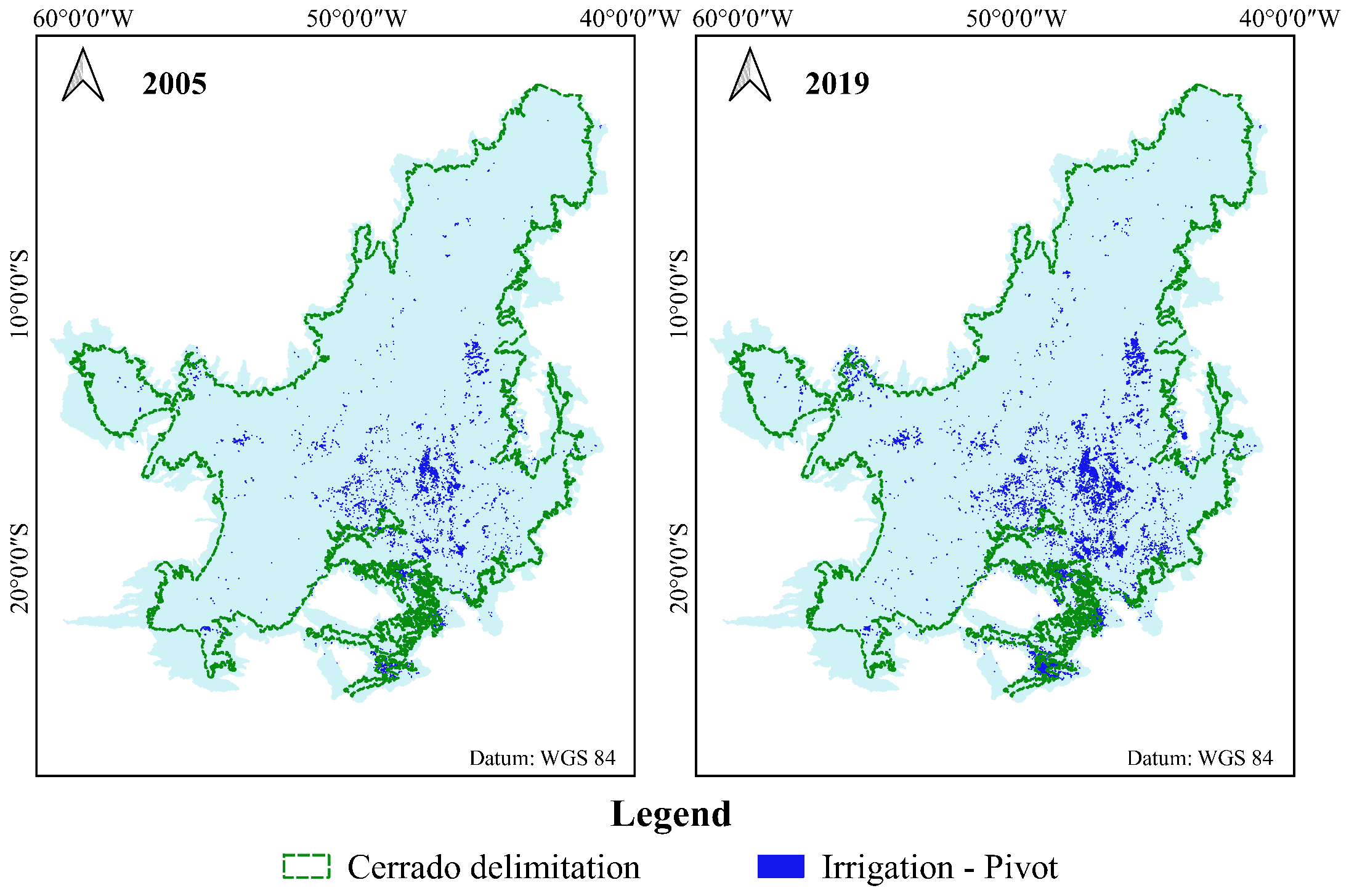
| JAN | FEB | MAR | APR | MAY | JUN | JUL | AUG | SEP | OCT | NOV | DEC | |
|---|---|---|---|---|---|---|---|---|---|---|---|---|
| CWB | 665 | 53 | 77 | 18 | 113 | 790 | 745 | 353 | 168 | 97 | 106 | 164 |
| % | 14.7 | 1.2 | 1.7 | 0.4 | 2.5 | 17.4 | 16.4 | 7.8 | 3.7 | 2.1 | 2.3 | 3.6 |
| Precipitation | 573 | 69 | 75 | 15 | 169 | 349 | 445 | 278 | 11 | 22 | 127 | 162 |
| % | 12.6 | 1.5 | 1.7 | 0.3 | 3.7 | 7.7 | 9.8 | 6.1 | 0.2 | 0.5 | 2.8 | 3.6 |
| ETo | 1155 | 30 | 304 | 33 | 389 | 1128 | 1009 | 725 | 750 | 731 | 95 | 125 |
| % | 25.5 | 0.7 | 6.7 | 0.7 | 8.6 | 24.9 | 22.3 | 16.0 | 16.6 | 16.1 | 2.1 | 2.8 |
| JAN | FEB | MAR | APR | MAY | JUN | JUL | AUG | SEP | OCT | NOV | DEC | |
|---|---|---|---|---|---|---|---|---|---|---|---|---|
| (mm) | ||||||||||||
| CWB | −13.3 | −8.2 | −1.4 | −0.9 | −3.6 | −3.0 | −0.4 | −1.2 | −0.2 | −1.4 | 4.5 | −10.2 |
| Precipitation | −11.7 | −8.2 | −1.9 | 1.6 | −2.8 | −5.2 | 0.1 | −0.7 | 0.5 | −3.7 | 5.7 | −9.0 |
| ETo | 2.1 | −1.2 | 0.6 | −1.0 | 0.6 | 0.6 | 0.4 | 0.2 | 0.6 | 0.7 | −0.9 | 1.0 |
Disclaimer/Publisher’s Note: The statements, opinions and data contained in all publications are solely those of the individual author(s) and contributor(s) and not of MDPI and/or the editor(s). MDPI and/or the editor(s) disclaim responsibility for any injury to people or property resulting from any ideas, methods, instructions or products referred to in the content. |
© 2023 by the authors. Licensee MDPI, Basel, Switzerland. This article is an open access article distributed under the terms and conditions of the Creative Commons Attribution (CC BY) license (https://creativecommons.org/licenses/by/4.0/).
Share and Cite
Ferreira, F.L.V.; Rodrigues, L.N.; Althoff, D.; Amorim, R.S.S. Spatial–Temporal Variability of Climatic Water Balance in the Brazilian Savannah Region River Basins. Water 2023, 15, 1820. https://doi.org/10.3390/w15101820
Ferreira FLV, Rodrigues LN, Althoff D, Amorim RSS. Spatial–Temporal Variability of Climatic Water Balance in the Brazilian Savannah Region River Basins. Water. 2023; 15(10):1820. https://doi.org/10.3390/w15101820
Chicago/Turabian StyleFerreira, Fernanda Laurinda Valadares, Lineu Neiva Rodrigues, Daniel Althoff, and Ricardo Santos Silva Amorim. 2023. "Spatial–Temporal Variability of Climatic Water Balance in the Brazilian Savannah Region River Basins" Water 15, no. 10: 1820. https://doi.org/10.3390/w15101820
APA StyleFerreira, F. L. V., Rodrigues, L. N., Althoff, D., & Amorim, R. S. S. (2023). Spatial–Temporal Variability of Climatic Water Balance in the Brazilian Savannah Region River Basins. Water, 15(10), 1820. https://doi.org/10.3390/w15101820









